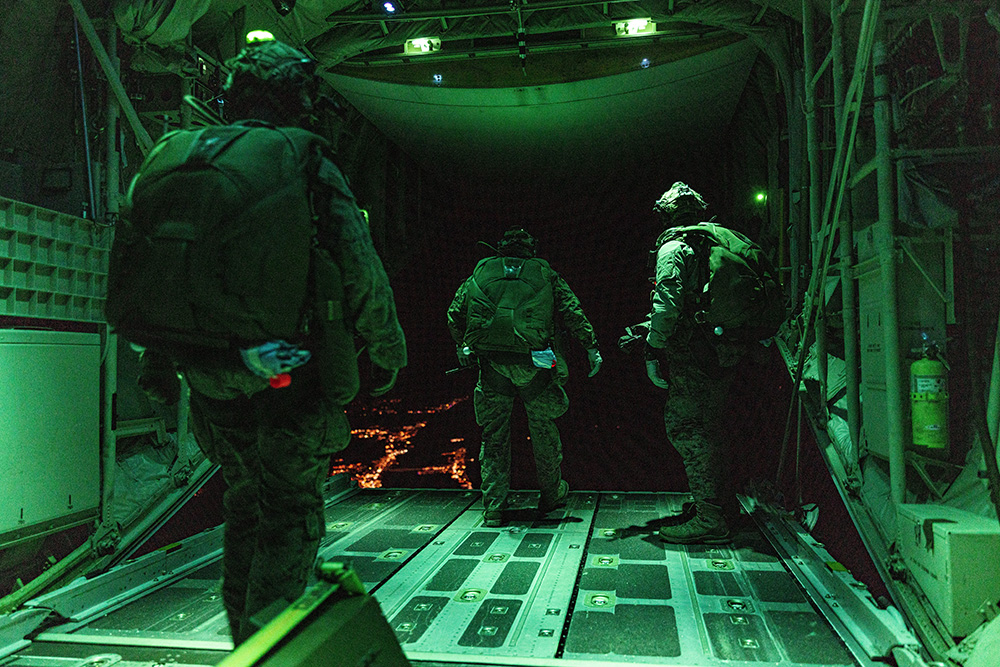The 26th Marine Expeditionary Unit flexes its muscles with completing its first intermediate pre-deployment training event, a Marine Air Ground Task Force Interoperability Course which took place from Nov. 28 to Dec. 12, 2022. This course was an opportunity to integrate multiple elements within the MEU to complete various scenario-based tasks and missions transitioning directly into Marine Expeditionary Unit Exercise I.
The Expeditionary Operations Training Group provided an assessment of essential objectives to be completed which include integrating individual and small unit skills, refine command and control procedures and refine standard operating procedures prior to deploying next year.
Scenario based events included company reinforced level raids, tactical recovery of aircraft personnel, Maritime Special Purpose Force missions, and intelligence gathering and planning. The training exercises were developed to give the MEU commander the maximum amount of flexibility in employment of their forces.
“My Marines and me personally now have more experience and knowledge integrating with the other elements of a MAGTF, understanding the kind of support and products they need.” – Cpl. Ethan Gore, a geospatial analyst with the S-2.
U.S. Marine Corps Capt. Mike Lowery, commander of the Maritime Special Purpose Force, 26th MEU, said this training highlighted the MEU’s capability to integrate MSPF with other sections to complete scenario-based missions.
“The Maritime Special Purpose Force is a Reconnaissance Company from 2nd Reconnaissance Battalion that is augmented with intelligence enablers, explosive ordinance Marines and a security force from the Battalion Landing Team,” he said. “The MAGTF Interoperability Course is a combination of raids, intelligence, TRAP and MSPF interoperability operations coinciding at the same time to show what the MAGTF can bring to the fight for our first exercise together.”
Lowery said that MSPF is the premiere reconnaissance and collections force for the 26th MEU which enhances the MEU’s commander awareness of the battle space with the support of other sections.
Participating in the course were Marines with the 26th MEU’s Intelligence Section, which practiced setting up a Tactical Sensitive Compartmented Installation Facility, planning and executing raids with the MSPF, BLT and ACE, as well as conducting scenario-based information collection operations.
One of the intelligence units that supported the scenario missions was the meteorology and oceanography section, which provided critical weather forecasts to assist in the planning process.

U.S. Marines with the Maritime Special Purpose Force, 26th Marine Expeditionary Unit, conduct a free fall insertion into Marine Corps Auxiliary Landing Field Bogue, North Carolina, Dec. 1, 2022. © Cpl. Kyle Jia
U.S. Marine Corps Cpl. Ethan Gore, a geospatial analyst with the S-2, said one of the events taking place within MAGTF Interop was Intelligence Interoperability, where intelligence Marines were supporting elements of the MAGTF during their scenario-based missions.
“Intel Interop was an opportunity for the S-2 to help communicate and coordinate with all the elements of the MEU that were participating in the course,” he said. “The intelligence products we produced were uniquely created for the pilots and Marines on the ground to use, and then when they finished their event, we received feedback from those units to refine our products.”
Gore said he hopes his Marines received new experiences working with the other sections.
“My Marines and me personally now have more experience and knowledge integrating with the other elements of a MAGTF, understanding the kind of support and products they need.” he said. “We were able to sharpen our tactics, techniques, and procedures as well as our standard operating procedures. MAGTF Interoperability was a unique training event and I feel everyone left more informed and better integrated.”
This is one of multiple training events scheduled prior to deploying to integrate, train for and execute real world missions and showcases the MEU’s as a Ready, Relevant and Capable force.





